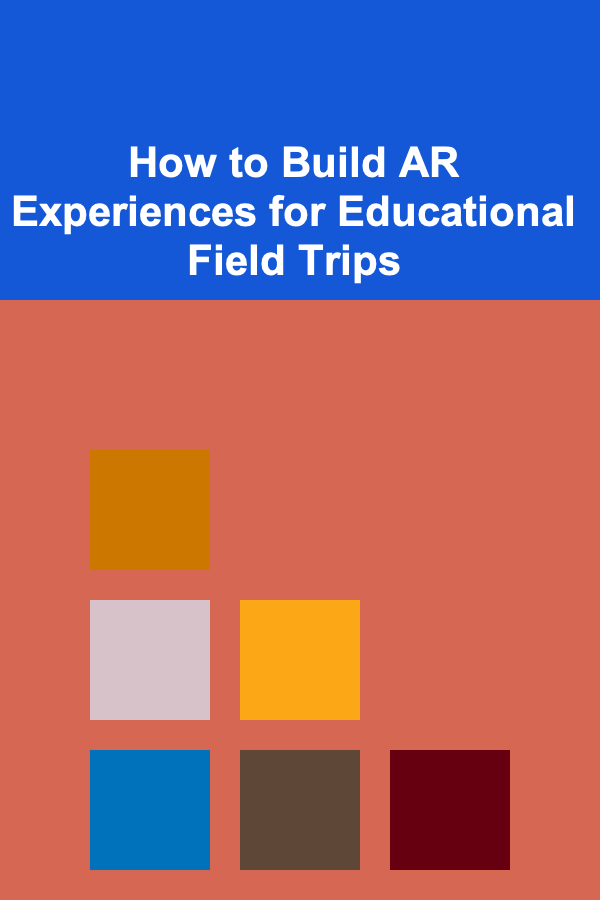
How to Build AR Experiences for Educational Field Trips
ebook include PDF & Audio bundle (Micro Guide)
$12.99$9.99
Limited Time Offer! Order within the next:

Augmented Reality (AR) has transformed the way we interact with the world around us, adding a layer of digital information to our physical environment. This technology has endless applications, from gaming and entertainment to industrial design and, notably, education. When it comes to field trips, AR can take educational experiences to an entirely new level, making learning immersive, interactive, and highly engaging.
In this article, we will explore how to build AR experiences for educational field trips, step by step. We'll cover the importance of AR in education, the benefits of using AR during field trips, and provide a comprehensive guide to designing and implementing AR experiences that enhance learning outcomes.
The Importance of AR in Education
Before diving into the specifics of building AR experiences, it is crucial to understand the role AR plays in modern education. AR bridges the gap between theoretical knowledge and practical experience, allowing students to visualize and interact with the content in ways that traditional learning methods simply cannot.
1. Active Learning and Engagement
Traditional classroom learning can sometimes be passive, with students receiving information from the teacher without much opportunity for interaction. AR, on the other hand, encourages active learning by enabling students to interact with the content and their environment in real time. During field trips, this dynamic interaction enhances engagement, making learning a hands-on, exploratory activity.
2. Personalized Learning
AR can cater to diverse learning styles by offering different modes of engagement, such as visual, auditory, and kinesthetic. This personalized approach ensures that each student can learn in a way that suits their individual preferences. For example, visual learners can benefit from 3D models, while auditory learners might enjoy narrated descriptions, and kinesthetic learners can explore physical objects in greater detail.
3. Immersive and Contextual Learning
Field trips often provide the unique advantage of learning in real-world settings. AR amplifies this by overlaying contextual information, historical facts, or interactive elements directly onto the objects and locations students are experiencing. Whether they're visiting a museum, a historical site, or a natural habitat, AR brings the environment to life with rich, immersive content.
Benefits of AR in Educational Field Trips
Integrating AR into educational field trips offers numerous benefits, both for students and educators. Let's take a closer look at how AR can enhance field trips and transform them into more meaningful, educational experiences.
1. Increased Engagement and Motivation
AR makes learning fun and exciting, which is particularly important for students who may not find traditional methods of education engaging. The interactive and gamified nature of AR encourages curiosity, sparks interest, and motivates students to actively participate in the learning process. For example, during a field trip to a historical site, students could use AR to see historical events unfold in front of them, creating a compelling reason for them to engage with the material.
2. Enhanced Understanding of Complex Concepts
Many subjects, such as science, history, and engineering, involve complex ideas that can be difficult to grasp. AR allows students to visualize abstract concepts in a tangible, interactive way. For instance, when visiting a botanical garden, students can use AR to explore the internal structure of plants, or when learning about ancient civilizations, they can watch reconstructions of historical landmarks right before their eyes.
3. Real-Time, Location-Based Learning
AR enables location-based learning, where the content delivered to students is contextually relevant to their surroundings. For instance, if students are on a field trip to an art museum, they can point their devices at a painting to unlock additional information about the artist, the techniques used, or the historical significance of the piece. This adds depth to the experience and allows students to learn as they explore.
4. Collaboration and Teamwork
Many AR applications encourage collaboration, allowing students to work together on challenges, share findings, or solve problems. During a field trip, students can use AR to engage in collaborative activities that require teamwork. For example, they could work together to find virtual clues in an archaeological dig, or collaborate to assemble a virtual reconstruction of a historical event, fostering communication and teamwork.
5. Safe Exploration and Experimentation
AR allows students to explore and experiment with concepts in a safe environment. For instance, in a science museum, students can interact with virtual representations of dangerous experiments or natural phenomena that they wouldn't otherwise be able to engage with directly. This makes it possible for students to learn about potentially hazardous materials or processes without any risk.
Steps to Building AR Experiences for Educational Field Trips
Building an AR experience for an educational field trip is a multi-step process that involves careful planning, design, development, and implementation. Below is a guide to help you through this process.
1. Define the Learning Objectives
Before you start creating any AR experiences, it is essential to define the educational objectives of the field trip. What do you want students to learn during the trip? Are you focusing on a specific subject, such as history, biology, or art? Understanding the purpose of the field trip and the specific knowledge you want students to gain will guide the AR content development.
For example, if the field trip is to a science museum, your objectives might include understanding the laws of physics, learning about famous inventors, or exploring scientific principles through interactive exhibits. Clear learning objectives will ensure that the AR experience is relevant and aligned with the educational goals of the trip.
2. Choose the Right AR Technology
The next step is selecting the appropriate AR technology and platform for your experience. There are a variety of AR tools available, ranging from mobile apps to advanced AR headsets. The type of technology you choose will depend on several factors, including your budget, the complexity of the experience, and the resources available to you.
Some popular AR platforms include:
- ARKit (for iOS devices)
- ARCore (for Android devices)
- Vuforia (a cross-platform AR development tool)
- Unity (for building interactive 3D AR experiences)
If you're creating a simple AR experience, a mobile app may be sufficient. For more complex experiences, such as those involving 3D models or virtual environments, you may want to explore AR headsets or custom apps that support interactive features.
3. Design Engaging AR Content
The content of your AR experience should align with the educational objectives of the field trip. It should also be designed to engage students and encourage interaction. Some ideas for AR content include:
- Interactive 3D Models: Create 3D models of historical landmarks, plants, animals, or scientific concepts. Students can interact with these models, rotating them, zooming in, or accessing additional information.
- Virtual Guides: Use AR to create virtual tour guides that appear as characters or animations. These guides can provide students with historical context, interesting facts, or explanations about the location or exhibit they are exploring.
- Gamified Challenges: Make the experience interactive by incorporating gamified elements, such as quizzes, scavenger hunts, or puzzles that students need to solve during the field trip. For example, students could use AR to find hidden objects around the museum or track down clues to a historical mystery.
- Augmented Text and Narration: Overlay text or audio narration that provides additional context or background information on the exhibits. This can be particularly useful for providing in-depth knowledge on complex subjects.
4. Develop and Test the AR Experience
Once you've designed the content, it's time to develop the AR experience using the chosen platform. If you're using a mobile app, you'll need to integrate AR features, such as object recognition, tracking, and spatial mapping, into the app. If you're using a custom AR headset, you may need to develop specialized software to support the interactive features.
Testing is crucial to ensure that the AR experience works seamlessly. Conduct pilot tests with small groups of students to ensure the app functions as expected and that the content is engaging. Gather feedback from students and teachers to refine and improve the experience before the actual field trip.
5. Prepare Students and Educators
To maximize the effectiveness of the AR experience, it's important to prepare both students and educators ahead of time. Provide training on how to use the AR technology and ensure that everyone is familiar with the app or headset. Offer guidance on how to engage with the AR content, including how to navigate the app, interact with virtual objects, and solve challenges.
You may also want to provide educators with a guide or checklist to help them facilitate the AR experience and ensure that students stay focused on the learning objectives.
6. Implement the AR Experience During the Field Trip
During the field trip, ensure that the AR experience is integrated smoothly into the visit. Ensure that all devices are fully charged and functioning, and that students are able to easily access the AR content. Encourage students to actively engage with the AR features, explore the content, and participate in any challenges or activities provided.
As students explore the field trip location, educators should facilitate discussions, encourage collaboration, and guide students through the AR experience. The goal is to enhance learning through the AR content while also fostering critical thinking and collaboration.
7. Evaluate the AR Experience
After the field trip, evaluate the success of the AR experience. Gather feedback from students, teachers, and other stakeholders to assess whether the learning objectives were met, whether the technology was effective, and whether students enjoyed the experience. Use this feedback to make improvements for future AR-powered field trips.
Conclusion
Building AR experiences for educational field trips is an exciting and innovative way to enhance learning and engagement. By incorporating interactive, immersive content, AR can bring field trips to life in a way that traditional methods cannot. Whether it's exploring ancient civilizations, studying biology, or understanding scientific principles, AR offers a unique way to interact with the world and deepen students' understanding of the material. With careful planning, the right technology, and engaging content, educators can create unforgettable learning experiences that students will cherish long after the field trip is over.

How to Invest in Mutual Funds for Steady Growth
Read More
How to Make Money Online as a Database Administrator: 10 Actionable Ideas
Read More
How to Sell Digital Products Successfully for Students: An Actionable Guide
Read More
How to Soundproof Walls Without Major Renovations
Read More
How to Stage an Empty Home to Help Buyers Visualize
Read More
How to Use Financial Apps to Stay on Track With Your Goals
Read MoreOther Products

How to Invest in Mutual Funds for Steady Growth
Read More
How to Make Money Online as a Database Administrator: 10 Actionable Ideas
Read More
How to Sell Digital Products Successfully for Students: An Actionable Guide
Read More
How to Soundproof Walls Without Major Renovations
Read More
How to Stage an Empty Home to Help Buyers Visualize
Read More